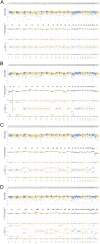Chromosomal alteration patterns in PitNETs: massive losses in aggressive tumors
- PMID: 39441837
- PMCID: PMC11729050
- DOI: 10.1530/ERC-24-0070
Chromosomal alteration patterns in PitNETs: massive losses in aggressive tumors
Abstract
The molecular biology of pituitary neuroendocrine tumors (PitNETs) revealed few recurrent mutations and extensive chromosomal alterations, with the latter being the driving force in a subset of these lesions. Addressing the need for an easily applicable diagnostic tool, we conducted a retrospective study of 61 PitNETs operated at a tertiary care center. All cases were subtyped according to the 2022 WHO Classification of Endocrine Tumors. A genome-wide next-generation sequencing panel targeting 1500 single nucleotide polymorphisms (SNPs) was used to classify chromosomal imbalances, loss of heterozygosity, and copy number variations in DNA from formalin-fixed paraffin-embedded tissues. We identified four distinct chromosomal patterns, with varying distribution among different tumor lineages. Forty-two of 61 (69%) PitNETs showed chromosomal alterations. Gonadotroph PitNETs showed mostly quiet genomes. The majority of lactotroph PitNETs (19/20, 95%) were altered, exhibiting a gained genome and a remarkably low recurrence rate. Nine of ten (90%) corticotroph PitNETs harbored chromosomal alterations, of which two aggressive corticotroph tumors and one metastatic corticotroph PitNET showed massive chromosomal losses, leading to near-haploid/near-homozygous genomes. The comparison of the molecular profile of primary and recurrent PitNETs of five patients showed no significant accumulation of alterations over time. A simple genome-wide 1500-SNP test can be used in the identification of outspoken aggressive subsets of PitNETs by the occurrence of a near-haploid/near-homozygous genome. Furthermore, the presence of neoplastic tissue in the resected material can be potentially confirmed for non-gonadotroph PitNETs under suboptimal histological assessment conditions.
Keywords: CNV; LOH; PitNET; PitNETs; SNP analysis; chromosome alterations; cnLOH; copy number alterations; endocrine pathology; endoreduplication; genome doubling; genome haploidization; loss of heterozygosity; molecular diagnostics; near-haploid genome; near-haploidization; near-homozygous genome; pituitary tumor; prolactinoma.
Conflict of interest statement
The authors declare that there is no conflict of interest that could be perceived as prejudicing the impartiality of this work.
Figures



Similar articles
-
Chromosomal instability in the prediction of pituitary neuroendocrine tumors prognosis.Acta Neuropathol Commun. 2020 Nov 10;8(1):190. doi: 10.1186/s40478-020-01067-5. Acta Neuropathol Commun. 2020. PMID: 33168091 Free PMC article.
-
Genome-wide loss of heterozygosity predicts aggressive, treatment-refractory behavior in pituitary neuroendocrine tumors.Acta Neuropathol. 2024 May 17;147(1):85. doi: 10.1007/s00401-024-02736-8. Acta Neuropathol. 2024. PMID: 38758238 Free PMC article.
-
Synchronous Multiple Pituitary Neuroendocrine Tumors of Different Cell Lineages.Endocr Pathol. 2018 Dec;29(4):332-338. doi: 10.1007/s12022-018-9545-4. Endocr Pathol. 2018. PMID: 30215160
-
scRNA sequencing technology for PitNET studies.Front Endocrinol (Lausanne). 2024 Jul 24;15:1414223. doi: 10.3389/fendo.2024.1414223. eCollection 2024. Front Endocrinol (Lausanne). 2024. PMID: 39114291 Free PMC article. Review.
-
Aggressive nonfunctioning pituitary neuroendocrine tumors.Brain Tumor Pathol. 2022 Oct;39(4):183-199. doi: 10.1007/s10014-022-00441-6. Epub 2022 Jun 20. Brain Tumor Pathol. 2022. PMID: 35725837 Review.
Cited by
-
Differential expression of PTEN, pAKT1, pRPS6, and mismatch repair proteins in pituitary neuroendocrine tumors.Virchows Arch. 2025 Jul 16. doi: 10.1007/s00428-025-04176-5. Online ahead of print. Virchows Arch. 2025. PMID: 40665163
References
MeSH terms
LinkOut - more resources
Full Text Sources
Medical

